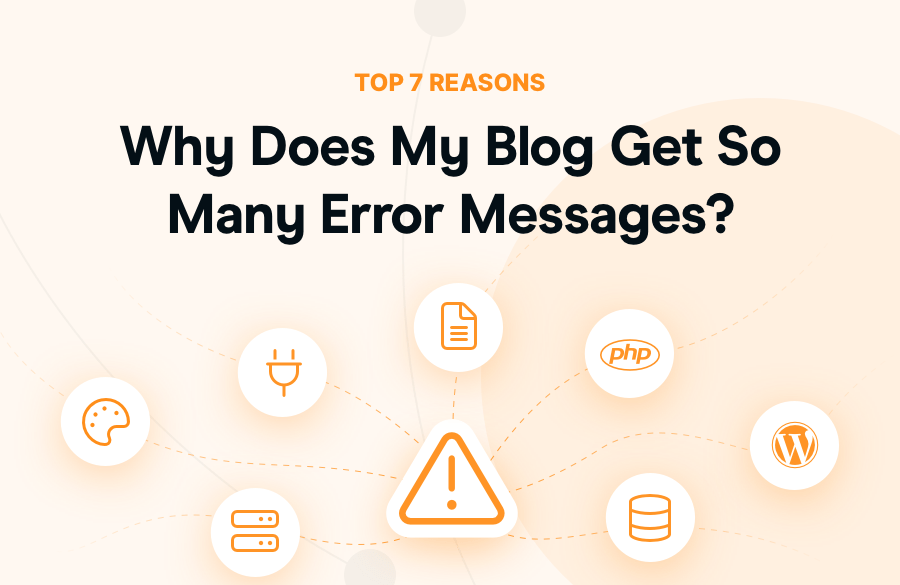
Why WooCommerce is Still Better Than Shopify
- •
- 4 min read

You might wonder why our articles so often blow our own trumpet – “Choose a reliable, managed hosting provider over shared hosting. Our strong maintenance support and security features are worth the extra money.”
You also might roll your eyes when every other article we write is a nagging reminder.
“Regularly backing up your websites is essential to safeguard against data loss. Keep your WordPress core, along with plugins and themes, frequently updated. Utilize a staging site to test changes. Monitor and regularly clear the cache.”
Annoying, isn’t it? Why do we keep repeating ourselves? In a nutshell, our goal is to help you prevent WordPress errors on your blog.
We don’t like errors. Nobody does. The fewer the better. How many errors did you encounter in the last year? Two? Three? How often did they happen? Blogger Outreach wrote about 35 common errors that website owners face. We’ve never seen so many errors. It makes you wonder what’s happening over there.
Our friends at codeable wrote up a manageable list of ten WordPress errors. Not too many, not too few. Ten is a safe, manageable amount, and they wrote a great article.
You don’t have time to worry about all the errors that might occur – you need to know about the errors that often do occur. Why? Because if we’re hosting your website, you’re not going to need to worry about errors – with the exception of 401s.
To ensure your WordPress blog runs smoothly, it’s essential to understand the bugs that can lead to issues and how to resolve them. The good news is that you can always pinpoint the source of the problem.
Here are the most common reasons for these WordPress error messages on your blog, and how you can effectively resolve them.
Your readers are the most important users of your website, so let’s start here. If they cannot access your content, everything else can wait. There are two common errors they can encounter: A Mixed Content/Insecure Website error and a Javascript error.
Mixed Content Errors: If your blog is using HTTPS but some resources are loaded over HTTP, this can cause mixed content errors. These degrade security and user experience. Ensuring all resources are loaded over HTTPS can resolve these errors. Most often this occurs when you import images or fonts from another website – your website may be HTTPS, but the source website is HTTP.
JavaScript Errors: Many websites can experience JavaScript errors due to differences in how browsers interpret JS. These errors might not visibly affect the functionality but can clutter the console with error messages. Using a caching plugin to minimize your JS and CSS can also cause sliders and contact forms to no longer function properly.
Plugins (there are more than 50,000) are the best way to extend the functionality of your WordPress site, but they can also be a double-edged sword. When multiple plugins try to perform similar tasks or interact with the same elements, conflicts can arise, leading to error messages. You may also be using a poorly-coded plugin. Ensure your plugins come from a trusted source.
Solution: Regularly update your plugins and deactivate (and uninstall) any that are not essential. If an error occurs after installing a new plugin, deactivate it to see if the issue resolves. Always ensure that your plugins are compatible with your WordPress version, and keep a backup of your site before updating.
“The single biggest reason that WordPress sites are compromised is through out-of-date software. You must keep on top of this because the hackers won’t put off hacking your site until you’re less busy.”
Rocket.net – Stay Safe and Keep Your WordPress Up To Date
Your theme is the backbone of your blog’s appearance and functionality. There are over 10,000 different themes available to you, so your blog will never look boring! However, not all themes are created equal. Poorly-coded themes or those that haven’t been updated can cause a myriad of issues. Just like your plugins, ensure your theme comes from the WordPress repository or a trusted vendor.
Solution: Choose themes from reputable sources and ensure they are regularly updated. If you encounter an error, switch to a default, classic, WordPress theme (like Twenty Twenty-One) to see if the problem persists. This can help you determine if the theme is the culprit.
Sometimes, the issue isn’t with your WordPress site at all but with your server. Server downtime, limited resources, or misconfigurations can lead to error messages.
A 400 error indicates that the server cannot process the request due to a client-side issue. A 500 error signifies that the server encountered an unexpected condition that prevented it from fulfilling a valid request.
A 401 error means that you are not authorized to access the page because you didn’t provide the right credentials, or there was another problem when authenticating your access. Often 401 error codes can be fixed by simply hitting the refresh button. What Is A 401 Error Code? (How To Fix It On WordPress)
There are a lot of ways user error results in HTTP 500 errors. Most of them, in our experience, come from editing the .htaccess file or installing a less-than-stellar plugin. We recommend that you test all new plugin installations and updates. Why Do I Get 500 Internal Server Errors? How to Fix It
Your WordPress site relies heavily on its database to store content and settings. Corrupt or inaccessible databases can lead to error messages, such as the dreaded “Error Establishing a Database Connection.”
Solution: Regularly back up your database and use tools like phpMyAdmin to repair and optimize it. If you encounter a database error, check your wp-config.php file to ensure your database credentials are correct. Sometimes a “0” looks like an “O,” right?
“Unlike some errors you may encounter — like the WordPress White Screen of Death (WSOD) — this error speaks for itself. It means there is no database connection. As far as website errors go, a database connection error is normally pretty easy to resolve.“
Rocket.net – 5 Ways How To Fix Error Establishing A Database Connection In WordPress
WordPress and its plugins require a certain amount of PHP memory to function correctly. If your site exceeds these limits, you’ll likely see error messages. These can occur due to syntax errors, memory limit issues, or deprecated functions in the code. By default, WordPress sets this limit to 32MB, but it can be increased to accommodate more resource-intensive tasks
Solution: Increase your PHP memory limit by editing your wp-config.php file or contacting your hosting provider for assistance. Ensure your site isn’t overloaded with unnecessary backup files, unused plugins, or deactivated themes.
Running an outdated version of WordPress can lead to compatibility issues and security vulnerabilities, resulting in error messages.
Solution: Always keep your WordPress core updated to the latest version. Regular updates ensure compatibility with plugins and themes and protect your site from security threats.
WordPress Errors are Not the End of the World
Blog error messages can come from a variety of sources. External factors can play a role, such as a poor internet connection or browser issues. To troubleshoot, first refresh your browser.
Errors can also stem from technical issues like server problems, plugin conflicts, theme problems, or coding errors. Follow up by checking your server status, clearing your browser cache, or updating your WordPress plugins and themes.
Error messages can be a nuisance, but they also provide valuable clues about what’s going wrong with your WordPress site.
By understanding the common causes and implementing these solutions, you can keep your blog running smoothly and focus on what you do best—creating great content.
Your blog might experience an increase in error messages due to server overload, hardware or software issues, database problems, code errors, or network difficulties. An unexpectedly high, or increased number of errors may also be a sign of increased website traffic or cyber attack.
Monitor your server logs, check website traffic, and view attempted log-ins — these are essential steps in troubleshooting for any blog owner.
When in doubt, contact your web administrator or provider. WordPress, out of the box, offers a website health check function. Use this together with a login protection plugin, and notifications from your hosting provider to get a clear picture of what’s behind increased error messages.
By investing in WordPress hosting, you’re equipping yourself with the tools and resources necessary to build a robust, secure, and high-performing online presence. Spend your time captivating and engaging with your audience. Let your hosting take care of the rest!